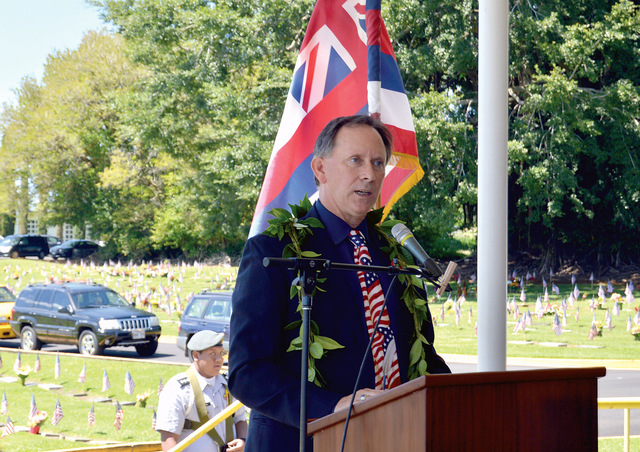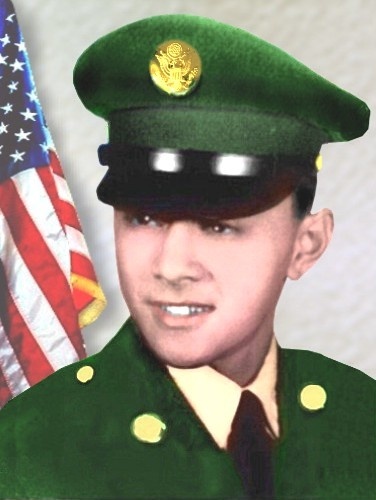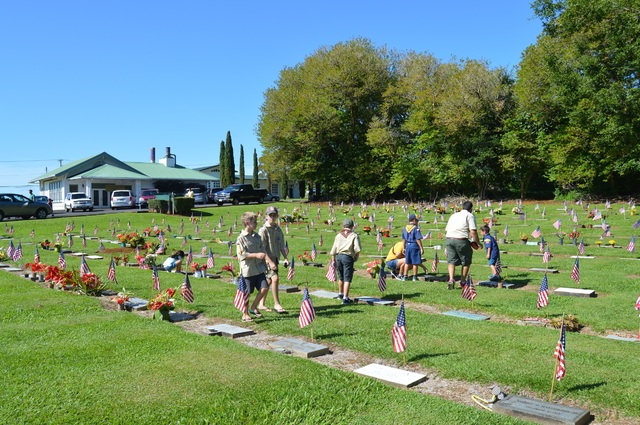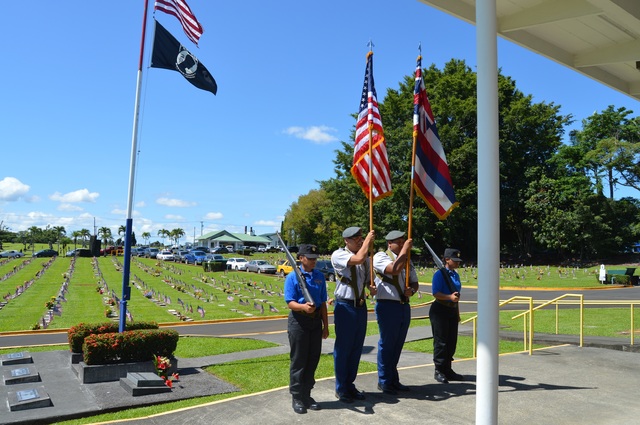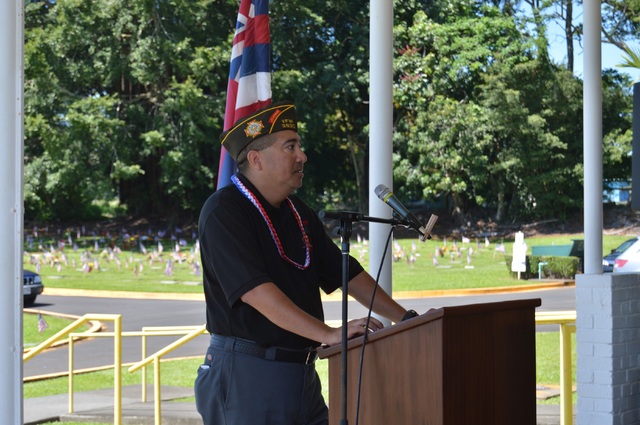A glorious, sunshiny day befitting the unofficial start of summer greeted the roughly 200 people who gathered Monday morning at East Hawaii Veterans Cemetery No. 1. to honor the men and women who gave their lives fighting America’s wars.
Hilo’s Memorial Day ceremony was organized by the Veterans of Foreign Wars Post 3830 in Pahoa. Keoni De La Cruz, the post’s commander and an Army veteran who served in the Iraq War observed, “To many, it’s a day off — barbecues, partying with families.”
“For us veterans, we remember those who fell before us,” he said. “… On this day, let us reflect on those who have fallen in the foreign wars before us, and those we’ve lost … many who I’ve lost personally, friends who I served with. They will always be remembered and never forgotten.”
De La Cruz recalled William Leroy Dulaney, an 86-year-old Marine Corps veteran whose surviving family members on the mainland weren’t immediately located after his death on March 18. When Post 3830 heard of Dulaney’s passing, they organized a graveside service with full military honors earlier this month.
“We honor you. And we are his family,” he said. “Nobody gets left behind.”
Anthony Marzi emceed the ceremony and called it “a great honor.” Marzi’s father, Dominic “Nick” Marzi, a Marine Corps veteran and “very active member of Post 3830,” died Sept. 16 at age 70.
Marzi gave a brief history of the national holiday.
“Decoration Day, also known as Memorial Day, is a tradition that came out of the American Civil War,” he said. “After a war that had taken a toll of over 600,000 Americans, or just over two-and-a-half percent of the U.S. population at that time, a tradition of every year bringing flowers to the grave was born. … In 1971, the White House issued a proclamation naming Memorial Day on this day in May every year. Their reason was that the flowers were at their peak at that time, to adorn the graves of the fallen soldiers and veterans.”
During the invocation, the Rev. Alan Tamashiro, pastor of Puna Baptist Church, said our nation’s fallen warriors “were full of life.”
“They loved and were loved,” Tamashiro said. “… We live in security and peace. We live protected by the laws of our land. And we thank (God) and our veterans for being able to live in a nation where life, liberty and the pursuit of happiness is possible.”
Said Mayor Billy Kenoi, “We are the land of the free because we are the home of the brave.”
The county’s chief executive honored Albert Kami of Hilo, who died May 7 at 91. Kami, a former Army Military Intelligence Service interpreter who served in occupied Japan, was the father of Clarysse Nunokawa, one of Kenoi’s executive assistants.
“He was one of the first to go in as an interpreter, and (with family) from Japan and wearing the uniform of the United States of America, how incredibly courageous and powerful that must’ve been for him,” Kenoi said. “That reminds all of us of the incredible sacrifice so many have made through the years.”
Retired Army Lt. Col. Douglass Adams, the keynote speaker, noted that 1.1 million Americans in uniform have made the ultimate sacrifice since 1775, the start of the Revolutionary War.
“Today at this ceremony, we remember and honor their courage under fire, their loyalty to their comrades and their steadfastness to the ideals of this nation, their commitment to their families and friends, and especially their sacrifice — a sacrifice under-girded by an unyielding sense of duty, an unimpeachable life of honor and an unwavering love of country,” Adams said.
Adams recounted the deeds of several individuals who died in service to the U.S., including a young man from Kona who was awarded the nation’s highest military honor, the Medal of Honor.
“Of the over 3,500 (Medals of Honor) presented since the Civil War, 18 percent have been awarded posthumously. Since 1941, though, over 60 percent have been awarded posthumously, including the Medal of Honor awarded to Sgt. 1st Class Rodney J.T. Yano of Kealakekua for his actions during the Vietnam War,” he said.
Yano, the grandson of Japanese immigrants, was a staff sergeant in the 11th Armored Cavalry Regiment serving as a helicopter crew chief and door gunner during combat near Bien Hoa on New Year’s Day 1969. His job was to deliver machine gun fire while marking enemy positions with smoke and white phosphorous grenades, allowing the aircraft’s commander to direct artillery fire. One of those grenades detonated inside the helicopter, rendering the pilot and co-pilot unable to see and causing the aircraft to lose altitude.
Burned, partially blinded and having lost the use of an arm, Yano threw and kicked the remaining ordnance from the chopper, while fragments from the grenade continued to catch fire and explode. He sustained additional wounds and died later the same day. Yano’s actions are credited with saving the lives of his crewmates and enabling them to regain control of the craft and fly safely to the 93rd Evacuation Hospital in Long Binh.
“His actions on Jan. 1, 1969, saved the lives of his crew at the cost of his own life,” Adams said. “The Medal of Honor citation lauds Sgt. 1st Class Yano’s ‘indomitable courage’ and ‘conspicuous gallantry’ as he threw blazing ammunition from his helicopter while already severely injured by a prematurely exploding grenade that cost him the use of one arm and partially blinded him. His actions continued to expose himself to the infliction of additional wounds until the danger was passed, by his actions.
“Indomitable courage, indeed.”
Yano, who turned 25 less than three weeks earlier, was posthumously promoted to sergeant first class. He is buried in the National Memorial Cemetery of the Pacific (Punchbowl) in Honolulu.
Email John Burnett at jburnett@hawaiitribune
-herald.com.






